Chapter 3 | Performance report | Commonwealth Ombudsman Annual Report 2006-07


CHAPTER 3 | Performance report
Introduction
This chapter details the performance of the office based on the outcomes and outputs structure set out in the Portfolio Budget Statements and Portfolio Additional Estimates Statements 2006–07.
The office of the Commonwealth Ombudsman has one outcome supported by two outputs:
- Outcome: Administrative action by Australian Government agencies that is fair and accountable
Output 1: Review of administrative action
Output 2: Review of statutory compliance in specified areas.
Our original price of outputs of $17.816 million was increased at Additional Estimates by $1.183 million for an increase in workload associated with the introduction of the Welfare to Work Programme, implementation of the Law Enforcement (AFP Professional Standards and Related Measures) Act 2006 and amendments to the Telecommunications (Interception and Access) Act 1979.
This chapter outlines our achievements against the outputs and broadly explains the ways in which we continue to work towards the outcome.
A financial overview is provided in Chapter 4—Management and accountability. Full details of the total price of agency outputs of the Ombudsman’s office are provided in Note 15 of the Financial Statements of this report.
Performance at a glance
TABLE 3.1 Summary of outcome and outputs price
Outcome 1: Administrative action by Australian Government agencies that is fair and accountable
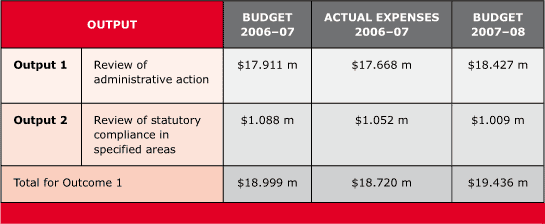
TABLE 3.2 Summary of outcome and outputs performance 2006–07
Output 1: Review of administrative action
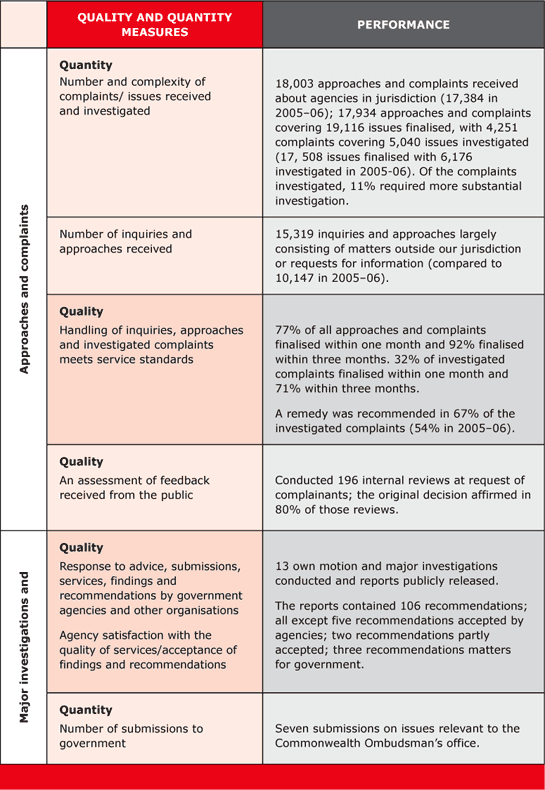
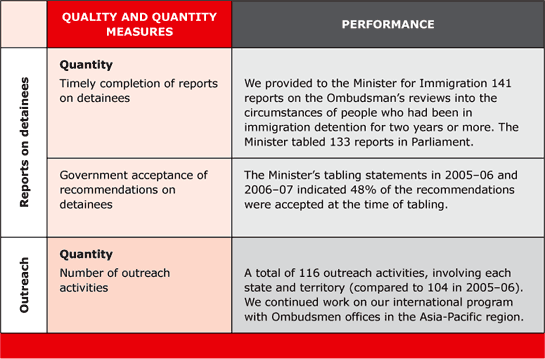
Output 2: Review of statutory compliance in specific areas

Output 1—Review of administrative action
1.1—Number and complexity of complaints/issues received and investigated and number of inquiries and approaches received
Approaches and complaints received
In 2006–07, we received a total of 33,322 approaches and complaints. Of these, 18,003 were about agencies within the Ombudsman’s jurisdiction (compared to 17,384 in 2005–06).
The categories of approaches to the office range from simple contacts that can be resolved quickly, through to more complex cases that require the formal use of the Ombudsman’s statutory powers. The decision to investigate a matter more formally can be made for a number of reasons:
- need to gain access to agency records by a formal statutory notice
- complexity or seriousness of the issue under investigation
- nature of the allegations made by a complainant
- time taken by an agency to respond to our requests for information
- likely effect on other people of the issues raised by the complainant.
In addition to the 18,003 approaches about agencies within our jurisdiction, we also dealt with approaches from members of the public that largely consisted of matters outside our jurisdiction or requests for information. We received 15,319 such approaches (compared to 10,147 in 2005–06 and 12,013 in 2004–05). It is difficult to point to a reason for this variability. It may relate to the general public profile of Ombudsmen at particular times, whether it be the Commonwealth Ombudsman, a state or territory Ombudsman, or an industry Ombudsman.
This year, we received 3,539 approaches and complaints electronically, an increase of 73% over 2005–06. Over the past four years, the percentage of approaches received electronically has increased from 5% to 11% of the total. We are continuing to look at ways to improve our online complaint lodgement processes.
There was a 54% increase in the number of approaches and complaints lodged in person and a 10% increase in the number of written approaches. Table 3.3 details approaches by method received.
TABLE 3.3 Approaches and Complaints, by method received, 2003–04 to 2006–07

* Under the Complaints Act, repealed at the end of 2006, the AFP’s Professional Standards Team notified the Ombudsman about complaints it received, for Ombudsman staff to oversee the AFP’s complaint-handling process.
Approaches and complaints by agency
Of the 18,003 approaches and complaints received about agencies within the Ombudsman’s jurisdiction, 13,326 (74%) were about Australia Post, the Australian Taxation Office (ATO), Centrelink, the Child Support Agency (CSA), and the Department of Immigration and Citizenship (DIAC).
Charts comparing trends over the past five years for these agencies are included in Chapter 7—Looking at the agencies.
Approaches and complaints finalised and investigated
We finalised a total of 33,234 approaches and complaints. Of these, 17,934 were about agencies within the Ombudsman’s jurisdiction (compared to 16,507 in 2005–06). We investigated 4,251 separate approaches and complaints, of which 11% required more substantial investigation, sometimes involving a high level of involvement of senior management and the use of formal powers (categories 4 and 5 in our classification system). Comparable data on the number of investigations requiring substantial investigation is not available for previous years.
Approaches and complaints made to the Ombudsman may include several issues. For example, a person may complain about a decision, as well as a service delivery aspect such as behaviour. Where a complaint contains several issues, it may result in different actions by the Ombudsman’s office in relation to the separate issues. We therefore also report on complaint issues finalised by the office.
In 2006–07 we finalised 17,934 approaches and complaints covering 19,116 issues about agencies within the Ombudsman’s jurisdiction. Of the approaches and complaints finalised, we investigated 24% (31% in 2005–06). The remaining complaint issues were usually finalised by referring the complainant to the internal complaint processes of the agency, or deciding that investigation of the issue was not warranted in all the circumstances.
‘ In 2006–07 we finalised 17,934 approaches and complaints covering 19,116 issues about agencies within the Ombudsman’s jurisdiction.’
The Ombudsman policy on administrative deficiency was reviewed and revised during 2006–07. Staff were provided with detailed guidance and training on what might constitute administrative deficiency, which can only be recorded in an individual case with the approval of a Senior Assistant Ombudsman. The Ombudsman wrote to agency heads advising them of the new policy, emphasising that the purpose of recording administrative deficiency is not to admonish agencies, but to identify deficiencies in agency processes highlighted by complaints to the Ombudsman. This informs the systemic work of the office. More details on the revised policy are in Chapter 5—Challenges in complaint handling.
Of the issues investigated and finalised, some agency error or deficiency was identified in 4% of complaints (compared to 1% last year, under the previous guidelines). The most common type of deficiency noted was unreasonable delay (28% of the cases), followed by human error (20%), flawed administrative process (19%) and procedural deficiency (13%).
Causes of complaint
As in previous years, the majority (64%) of the complaint issues finalised by the Ombudsman’s office under the Ombudsman Act 1976 related to the correctness, propriety or timeliness of a decision or action of an agency. The remainder of the complaint issues finalised related to procedural matters, such as the accuracy or completeness of advice given by agencies (11%), the conduct of officers in agencies (4%), or the application of a policy to the complainant’s circumstances (3%).
Complaints carried forward
The total number of complaints carried forward (past 30 June 2007) was 1,316 compared to 1,298 at 30 June 2006. A backlog will always exist as some complaints are received late in the reporting period. It also arises from the complexity of some complaints and the correspondingly longer period of time required to investigate them.
1.2—Handling of inquiries, approaches and investigated complaints meets service standards
Timeliness
Our service charter indicates that we aim to investigate complaints as quickly as possible, acting fairly, independently, objectively and impartially.
In 2006–07, we finalised 77% of all approaches and complaints within one month of receipt (in line with previous years), and finalised 32% of investigated complaints within one month (compared to 54% in 2005–06 and 65% in 2004–05). As noted below, changed work practices make this comparison unreliable.
FIGURE 3.1 shows the time taken to finalise all approaches and complaints for the periods 2003–04 to 2006–07.
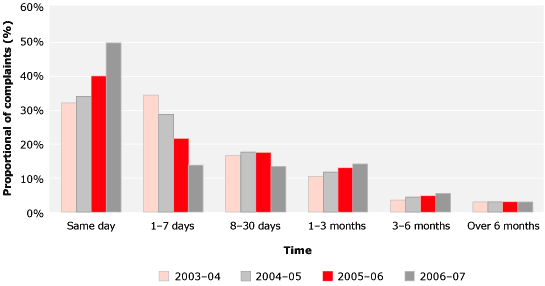
Data from our complaint management system is used to monitor response times by the office and to identify delays in complaint investigation. With many of the complaints we investigate, we need to factor in the time that it takes an agency to provide us with information. This may reflect the complexity of the issues, the number of different areas of the agency that need to be consulted, and in some cases the need for cross-agency responses.
There are sharp variations in the time it takes to finalise investigated complaints about different agencies, as Table 3.4 shows. In the case of complaints about the Australian Federal Police (AFP), this is partly due to different legislative requirements relating to complaints received before 2007 (see ’ Law enforcement’ section in Chapter 7 for more detail).
TABLE 3.4 Time to finalise investigated complaints for selected agencies, 2006-07
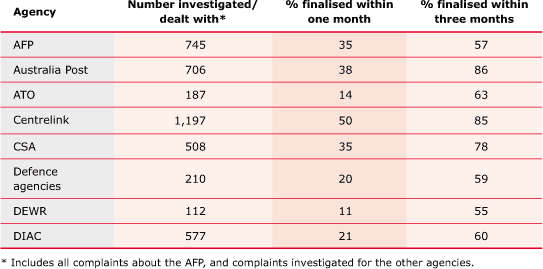
In part the decrease in timeliness of investigating complaints is due to some changed work practices that do not necessarily have an impact on complainants. For example, all investigated complaints are subject to quality assurance before closure, and we routinely advise complainants of our intended conclusion and give them a period of time to respond to this information before finalising the complaint. Under our previous work practices, formal quality assurance occurred after a complaint was finalised, and we could re-open a complaint if the complainant took issue with our conclusions. The latter process was separate to our formal review processes, described later in this chapter.
The decrease in timeliness of investigating complaints would be of concern if it reflected a drop in efficiency rather than the work practice changes, such as those identified above, which have little impact on most complainants. We are examining our data and work practices in more detail to ensure that we fully understand the causes, and to make sure we identify any changes which may be required in our practices to improve efficiency. This analysis will take some time to complete.
Remedies
Our service charter advises that, if appropriate, and where possible, we will recommend changes to fix a problem.
The most common remedy for complaints was the provision of a detailed explanation by an agency of its decision or action (26% of cases where a remedy was identified). Other major types of remedy were an explanation of the circumstances by the Ombudsman’s office (19%), agency action being expedited (13%), agency decision changed or reconsidered (11%), a financial remedy (11%) and an apology being offered by an agency (9%).
A remedy was identified in 67% of the complaints investigated (compared to 54% in 2005–06 and around 68% in the previous two years). A breakdown of remedies is provided in Appendix 4—Statistics.
Decisions not to investigate
Our service charter indicates that if we do not investigate a complaint we will explain why, and advise the complainant of any other avenues to pursue their complaint.
The legislation administered by the Ombudsman gives the office a range of discretionary powers not to investigate matters in particular circumstances. We most commonly decide not to investigate if a person has not raised their complaint with the agency. There can be advantages for both the complainant and the agency in an issue first being raised at the source of the problem and an attempt made to resolve it before external intervention. This year we advised the complainant to take their concerns up with the relevant agency in the first instance in 60% of the matters within the Ombudsman’s jurisdiction.
Many agencies have worked on improving their internal complaint-handling mechanisms, and have appropriate procedures in place to respond to dissatisfied clients. The Ombudsman is more likely to accept a complaint without the matter first being handled by the agency in the following circumstances:
- the relationship between the person and the agency is difficult
- the person is effectively unable to manage their own complaint, whether because of agency recalcitrance or the person’s inability to articulate their problem
- it is doubtful that the complaint will be handled adequately by the agency, whether because of the nature of the complaint or the effectiveness of the agency’s complaint mechanism.
We recognise that some complainants are reluctant to raise their concerns with the agency involved for a number of reasons. In the ‘Looking at the agencies—Australian Taxation Office’ section in Chapter 7, we describe a trial the office has undertaken of directly assisting the transfer of tax complaints to the ATO.
While a large number of approaches and complaints are outside the Ombudsman’s jurisdiction, or are not investigated, we endeavour to provide a high level of service to these people and refer them to more appropriate avenues to resolve their concerns wherever possible. The description of the work of the Public Contact Team in Chapter 5—Challenges in complaint handling provides more insights into the services we provide.
1.3—Assessment of feedback received from the public
We apply the same principle to our own operations that we espouse for other Australian Government agencies: specifically, if a person is not satisfied with the way in which we have dealt with the issues they have raised, there is a clear procedure by which they can seek an internal review of the matter.
In November 2006 we revised the way in which we deal with requests for review. This was to ensure that we deal with such requests consistently and with the highest level of integrity and care, and to maximise organisational learning from these requests. The office established a Review Panel, overseen by a Deputy Ombudsman, and comprising Senior Assistant Ombudsmen and a number of senior, experienced investigation staff. The Deputy Ombudsman considers each request for review. If a decision is made that a review should be undertaken, the Deputy Ombudsman allocates it to a member of the Review Panel, who is more senior to the initial investigation officer, and who was not directly involved in the handling of the original complaint.
Information on the internal review process offered by the office is available on our website and included in correspondence and other communication with complainants. If a person requests a review when they are notified by telephone of an intended investigation conclusion, we print out a ‘request for review’ form and send it to them. If they are unable to articulate their concerns clearly, we assist them to fill in the form.
In the reporting period we received 205 requests for internal review, more than twice as many requests as were received in 2005–06. We finalised 196 reviews during the year: some were carried over from 2005–06 (Table 3.5). Of the finalised reviews, the original outcome was affirmed in 157 reviews (80%). This was almost the same percentage as last year (85%) and the same as in 2004–05. The office decided to conduct additional investigation after 33 reviews and to change its decision on the original complaint in four reviews. Two reviews were withdrawn by the complainant.
TABLE 3.5 Internal review of Ombudsman action, requests and decisions, 2006–07
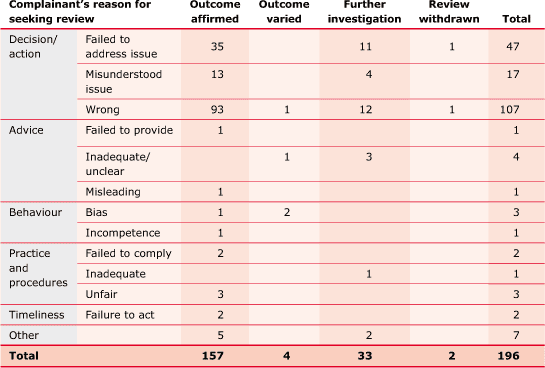
Of the 196 reviews finalised, 87% related to decisions or actions of an officer in the course of complaint investigations. The main reasons expressed by complainants for seeking a review were that they believed the decision we made or advice we offered was wrong or that we failed to address or misunderstood the complaint issue.
1.4—response to advice, submissions, services, findings and recommendations by government agencies and other organisations, and agency satisfaction with the quality of services/acceptance of findings and recommendations
 The Ombudsman released public reports on 13 own motion and major investigations:
The Ombudsman released public reports on 13 own motion and major investigations:
- December 2006—Department of Immigration and Multicultural Affairs: report into referred immigration cases: Mr G (Report No 6/2006)
- December 2006—Department of Immigration and Multicultural Affairs: report into referred immigration cases: mental health and incapacity (Report No 7/2006)
- December 2006—Department of Immigration and Multicultural Affairs: report into referred immigration cases: children in detention (Report No 8/2006)
- April 2007—Australian Taxation Office: administration of garnishee action (Report No 1/2007)
- May 2007—Australian Film Commission: investigation into the assessment of film funding applications (Report No 2/2007)
- May 2007—Complaint handling in Australian airports: own motion investigation (Report No 3/2007)
- June 2007—Australian Defence Force: management of complaints about unacceptable behaviour (Report No 4/2007)
- June 2007—Migration Agents Registration Authority: complaint-handling process (Report No 5/2007)
- June 2007—Review of ACT Policing’s Watchhouse operations: joint report by the Australian Federal Police and the Commonwealth Ombudsman (Report No 6/2007)
- June 2007—Department of Immigration and Citizenship: report into referred immigration cases: detention process issues (Report No 7/2007)
- June 2007—Department of Immigration and Citizenship: report into referred immigration cases: data problems (Report No 8/2007)
- June 2007—Department of Immigration and Citizenship: report into referred immigration cases: notification issues (including cases affected by the Federal Court decision in Srey) (Report No 9/2007)
- June 2007—Department of Immigration and Citizenship: report into referred immigration cases: other legal issues (Report No 10/2007).
The reports contained a total of 106 recommendations. Of these, 101 recommendations were accepted by the agencies involved, and three were matters for government. In the case of two other recommendations, which involved a number of agencies, most agencies accepted the recommendations.
The acceptance by agencies of the overwhelming majority of the Ombudsman’s recommendations indicates a high degree of satisfaction with our capacity to conduct thorough, rigorous and fair investigations. In addition, a number of these investigations were undertaken at the request of the Australian Government, and one was conducted jointly with the agency in question (the AFP).
Several own motion, systemic and major investigations currently in progress will be completed in 2007–08. These include investigations into:
- issues relating to the implementation of the marriage—like relationship policy
- the quality of the notification of reasons by DIAC for decisions and review rights for refused visa applicants
- matters involving HMAS Westralia
- a range of issues related to implementation of Welfare to Work.
More details are provided in Chapter 7—Looking at the agencies.
1.5—Number of submissions to government
During the year we made seven submissions to government:
- Senate Legal and Constitutional Affairs Committee inquiry related to the proposed introduction of significant new search and seizure powers for Centrelink officers
- Senate Legal and Constitutional Affairs Committee inquiry into the provisions of the Crimes Legislation Amendment (National Investigative Powers and Witness Protection) Bill 2006, in relation to controlled operations and delayed notification search warrants
- Parliamentary Joint Committee on Corporations and Financial Services regarding its inquiry into the Exposure Draft of the Corporations Amendment (Insolvency) Bill 2007
- Joint Committee of Public Accounts and Audit inquiry into taxation administration in Australia
- Australian Law Reform Commission review of the Privacy Act 1988
- Australian Law Reform Commission inquiry into legal professional privilege and Commonwealth investigatory bodies
- Inspector-General of Taxation review into the underlying causes and management of objections to Australian Tax Office decisions.
We also appeared before the Senate Foreign Affairs, Defence and Trade Committee regarding the performance of the military justice system.
1.6—Timely completion of reports on detainees, and government acceptance of recommendations on detainees
In June 2005 the Australian Parliament amended the Migration Act 1958 to confer on the Ombudsman the role of reviewing the cases of people who had been in immigration detention for two years or more. By the end of June 2006, we had received 235 reports from DIAC concerning 262 people who had been in detention for two years or more. We provided reports to the Minister for Immigration on 70 cases, and the Minister had tabled responses on 66 of those reports.
During 2006–07 we received a further 222 reports from DIAC, covering a total of 290 people. We provided a further 141 reports to the Minister. A number of these reports were combined reports (for example, combined first and second reports for a person whom we had not reported on before we received their second report from DIAC). The Minister tabled responses on 133 reports.
Of the 218 recommendations or suggestions made by the Ombudsman in the 211 reports provided to the Minister as at 30 June 2007, the Minister agreed to 48% of the recommendations, disagreed with 34%, and delayed making a decision on a further 13%. On some occasions a different decision was made later. In 2% of the cases, the recommendations became irrelevant because of intervening circumstances, and 3% of the recommendations were not addressed.
1.7—Number of outreach activities
Our outreach program continues to have two components: to raise public awareness of our role; and to contribute to the development of the role of the Ombudsman in the Asia-Pacific region.
Raising public awareness
In March 2006, we commissioned a market research company to conduct a Public Awareness Benchmark Survey. The survey explored the level of knowledge of the role of the Ombudsman’s office among rural and regional Australians, as well as the depth of understanding of our role held by rural and regional community leaders.
We repeated the general survey of rural and regional Australians in June 2007. The results were broadly similar to those in 2006. The survey showed a continued high level of unprompted awareness of ‘the Ombudsman’ as an avenue to resolve complaints about Australian Government departments and agencies, although the overall percentage had decreased. It also showed ‘the Ombudsman’ was now the preferred avenue to resolve complaints. We are analysing the results in more detail to help better target our outreach activities.
We conducted 116 outreach activities during the year, which covered all states and territories. We continued to focus on community information ‘gatekeepers’, to inform them of our role and to listen to their concerns and observations about government service delivery.
We continued our program of seminars for federal members and electorate staff through the year, with sessions being held in each state.
In November 2005 an Indigenous Working Group was established within the office to consider the best way of communicating with, and providing service to, Aboriginals and Torres Strait Islander people, communities and organisations. The group provided an interim report to the Ombudsman in mid-2006. The Ombudsman agreed to the report’s recommendations and we are working to implement them. More detail is included in Chapter 5—Challenges in complaint handling.
Role of Ombudsmen in the Asia-Pacific region
We continued our involvement in strengthening mutual support among Ombudsmen in our region. Key geographic areas for our international program involvement have been two South-East Asian neighbours, Indonesia and Thailand, and countries in the South Pacific, including Papua New Guinea, Samoa and Vanuatu. The Australian Agency for International Development provided funding for these activities. Further details about our international program are in Chapter 6—Promoting good administration.
Output 2—Review of statutory compliance
Timely completion of the inspecting/reporting schedule, government and agency acceptance of and satisfaction with the quality and relevance of inspection findings and recommendations and number of inspections completed by category
The Ombudsman is required to inspect the records of the AFP, the Australian Crime Commission (ACC), the Australian Commission for Law Enforcement Integrity (ACLEI), and other agencies in certain circumstances, in accordance with three Acts as noted below. We report to each agency on the outcome of each inspection in addition to the statutory reporting requirements to the Minister or to Parliament.
At the completion of each inspection, a draft report is forwarded to the respective agency for comment, and those comments are considered in producing a final report. This procedure allows agencies to be heard before we make any findings or recommendations, and agencies are more likely to accept our position. We do not ask agencies to formally acknowledge any objections once they have received the inspection report. We understand that all of the Ombudsman’s findings in reports finalised in 2006–07 were accepted by the relevant agencies.
Telecommunications interception records
Under the Telecommunications (Interception and Access) Act 1979 (TIA Act), the Ombudsman is required to inspect the records of the AFP, the ACC and ACLEI, and other agencies in certain circumstances, to ensure telecommunications interception activities and accessing of stored communications is in accordance with the provisions of the TIA Act. In 2006–07, we carried out three inspections of the AFP and two inspections of the ACC.
The TIA Act also requires the Ombudsman to report to the Attorney-General in writing before 30 September each year on the results of the inspection of each agency during the preceding financial year. In accordance with this obligation, reports to the Minister were provided for the AFP and the ACC within the required timeframe.
Surveillance device records
Under the Surveillance Devices Act 2004 (Surveillance Devices Act), the Ombudsman is required to inspect the records of the AFP, the ACC and ACLEI, and those state law enforcement agencies that have utilised powers within the Act, to ensure use of surveillance devices is in accordance with the Act. We carried out three inspections of the records of the AFP, two inspections of the ACC, and one each of New South Wales Police and South Australia Police.
The Surveillance Devices Act also requires the Ombudsman to make a written report to the Attorney-General bi-annually on the results of the inspection of each agency during the preceding six months. The Attorney-General tables the reports in Parliament. The results from the first AFP and ACC inspections were reported to the Attorney-General in February 2007, and the results of the other inspections will be reported to the Attorney-General within the required timeframe.
Controlled operations records
Under Part 1AB of the Crimes Act 1914 (Crimes Act), the Ombudsman is required to inspect the records of the AFP, the ACC and ACLEI to ensure compliance with Part 1AB. In 2006–07, we inspected the controlled operations records of the AFP on three occasions and the ACC on two occasions.
Part 1AB of the Crimes Act also requires the Ombudsman to report to the President of the Senate and the Speaker of the House of Representatives on the inspections carried out in the previous financial year, and to brief the Parliamentary Joint Committee on the activities of the ACC. An annual report for 2005–06 was presented to Parliament in December 2006 and the briefing occurred in March 2007.
Building industry taskforce records
Section 88AI of the Workplace Relations Act 1996 previously required the Ombudsman to review the use of coercive powers exercised by the Secretary of the Department of Employment and Workplace Relations and his delegate, the Director of the Building Industry Taskforce. An inspection pursuant to those requirements was conducted in early 2006 and a report was provided to the President of the Senate and the Speaker of the House of Representatives in October 2006. The Ombudsman is no longer required to review such matters.
